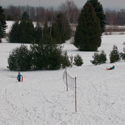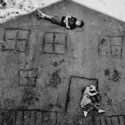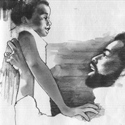Now that we've reached the end of this growing season, I thought I'd give a final update on the garden project that occupied so much of our time this summer. These days I'm mostly clearing out sunflower stalks and dying flowers, and hoping for enough sunlight for the last of the tomatoes to ripen. With my daughter in school every day, we don't get to spend as much time as we'd like at the garden, and things are really winding down. But since I last wrote, some things did get pretty out of control:
I never expected the limited amount of soil in those boxes to support such growth, particularly all the "cucurbita" plants (zucchini, summer squash, acorn squash, pumpkins, and the strange plant I bought at the Vietnamese grocery store). Part of the garden was so overgrown with their massive leaves and stretching vines that the aisles became a real challenge to navigate. Next year, I have better plans for those plants.
In early August, I noticed a mildew developing on some of the pumpkin leaves. Within a week it spread to the rest of the cucurbita leaves, and although it broke my heart I cut out about 80 percent of the vines that I had been watering for months. I lost my grape vines to a similar blight. The garden suddenly looked naked.
In the first post, I mentioned the water situation at the garden. When that was published, I was hauling 25-50 gallons of water there every day in multiple 5-gallon containers. I grew to respect why nearly every great city in the world was founded on a river. In mid-July I bought and installed a rain barrel. The first time it rained, the new weight in the barrel made it fall off the stand I built, so I had to rebuild a solid one with bricks I picked from the ruins of the old Rhino club. The second time it rained, I can't even describe the feeling of just turning the nozzle and watering the flowers with water that was right there. Thankfully, August and September were much wetter than July.
During the height of our harvest, we brought home bushels of cherry tomatoes, a dozen ears of sweet corn, eight stalks of broccoli, more Hungarian peppers than we could eat or pickle, plenty of zucchini, and enough pickles for a full shelf of jars. We picked four acorn squash before ripping out the vines for mildew (acorn squash is a favorite at our house; we simply gut them, pour in olive oil and butter with salt and a few fresh herbs, then roast for 45 minutes). We had to eat the watermelon prematurely, but we did it at the garden and it was a lot of fun.
Soon all the annual flowers will be dead, and the basil is near its end. We'll still have kale, beets, and I'm waiting on the four stalks of brussels sprouts.
I was spending so much time at the garden that I started to look beyond the lot at the rest of the block. It's an interesting little part of the city, dating almost back to Judge Woodward's original street plan as far as I can tell from the maps. This block would have been used to load materials on and off wagons in the old days, and was just called "Service Street." The big warehouse dates back to the mid-nineteenth century, and was once used to manufacture concrete tubs. I have always loved brick roads, ever since my mother used to go out of her way to drive us down the brick road in my hometown to remind us that my father's grandfather was a bricklayer who worked on that very street.
Other than one homeless man in the overgrown alley, no one lives on this block. One day we watched as he made multiple trips out of his alley dragging a huge blue tarp covered with trash. "You inspired me!" he said as he hauled the trash to a distant dumpster. He started making neat little piles of bricks and brush he cleared from the alley, and stored bottles of water in the area he cleared out:
Most of the vacant property on the block is still owned by the Stroh's family (it's across the street from where their old brewery stood). One of the most frustrating things about this project has been trying to keep the block clean of the trash that accumulates daily. Every few weeks I throw away a pair of wet blue jeans stuffed in a toilet seat left in the same spot. Where do they keep finding these toilet seats? One day I found a bra (36D) hanging on the fence around the garden. Mostly though I find food containers, plastic liquor bottles, and women's shoes (in that order). I have been working in the garden and watched people throw trash over the fence as though I wasn't even there.
Despite the relentless garbage, there have been bright spots. I've met a lot of people who just stop by while I'm working, and some anonymous artists have done little things to brighten up the block. The graffiti tags are another matter. I got sick of looking at these ugly ones on the warehouse across from the garden.
At the northeast end of Service Street, there's an art gallery/capoeria studio that hired a Detroit artist to do a colorful brick-by-brick paint job on the corner, and it occurred to me that this was a great deterrence to these ubiquitous black and white bubble-letter tags that were becoming more and more common in our neighborhood. And at the southwest end of the block, on the bricks of the old Taj Perfume Company building there's a fading geometric mural reportedly done by a guy named Steve Foust in 1973:
I asked the Busy Bee folks (who also own the full-block warehouse) if we could cover the graffiti with a painted pattern to resemble the stripes of a bee, in the same color scheme they use on their operating business across the street. Although I knew it would bright and attention-grabbing, I liked the idea of continuity of brightly painted bricks all along Service Street. With the help of an excellent group of people from the Lafayette Park soccer team (on one of the hottest days of the year), we sweated and meticulously covered up the graffiti the entire length of that warehouse, brick-by-brick. Busy Bee donated the paint, buckets, and brushes, and with the soccer team's help, we transformed the graffiti-covered wall:
An ice cream truck even stopped by to give us free treats, thanking us for making the city a little brighter.
I even painted the rain barrel with bee stripes, and our secret neighborhood beekeeper has installed a nice hive in the garden:
He says the honey tastes great. I believe it. Those bees have been busy all summer.





















































